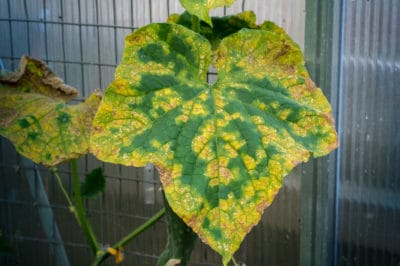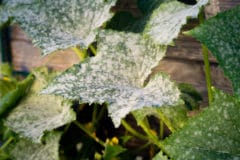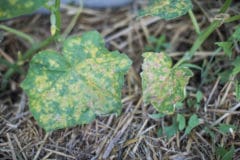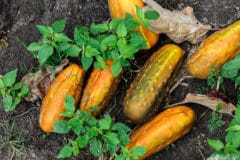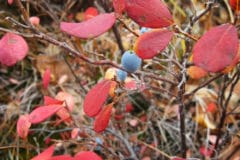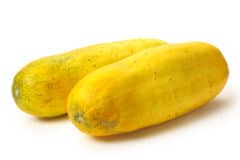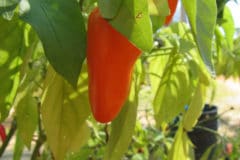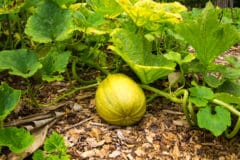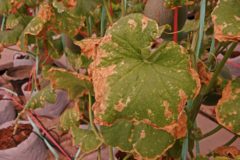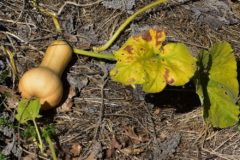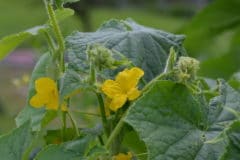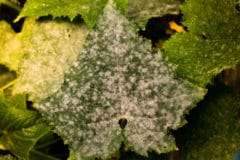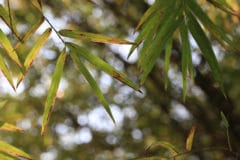Chlorophyll and Chlorosis
Officially, your cucumbers’ distressing condition is chlorosis, or a lack of chlorophyll — the green leaf pigment responsible for capturing sunlight to fuel food production. Without enough chlorophyll, the plants go hungry — sometimes to the point of starving. To accurately pinpoint why chlorosis is happening, however, you need to study your cukes for other clues.
Pests and Yellowing Cuke Leaves
Infestation by a trio of sap-stealing pests leads to chlorotic cuke leaves. Fortunately, each causes other symptoms:
- If your cukes have yellow-stippled leaves with fine silvery webbing draped from their underside, microscopic spider mites are at work.
- If your cukes have malformed yellow leaves that curl under at the edges, suspect aphids. They mass on the stems and leaf backs and love to feast on new growth. Aphids also cover their feeding sites with clear, gooey honeydew.
- If a cloud of miniature white moths rises from the yellow leaves when you shake them, you’re looking at whiteflies. Just like aphids, they excrete honeydew.
For organic control of these bugs, treat your cucumbers with insecticidal soap. Spray until it drips from all their surfaces and reapply at the label’s recommended frequency.
Expert gardener’s tip: Cukes severely infested with whiteflies should be removed and disposed of in sealed bags.
Disease and Yellowing Cuke Leaves
Diseases often blemish cucumbers with yellow spots and/or streaks.
Downy Mold
Leaves infected with downy mold develop yellow spots on their upper surfaces and grayish mold underneath. Cool conditions and splashing water encourage the disease. Organic control measures include:
- Trellising your plants to improve air flow.
- Watering them from beneath the leaves remain dry.
- Spraying infected plants to runoff with a mixture of 1 teaspoon (4.9 ml) each of baking soda and horticultural oil in 1 quart (.96 liter) of water. Be sure to hit the backs of the leaves.
Fusarium Wilt
Fusarium wilt turns a cuke’s older leaves yellow from the edges inward as its runners slowly die. It’s spread by cucumber beetle larvae feeding on roots. Remove the infected plants and plant debris. To limit future outbreaks, protect your plants with lightweight row covers. Their permeable fabric keeps beetles away but allows light, moisture and air in.
Anthracnose Leaf Spot
An anthracnose infection begins with water-soak leaf spots that turn yellow and then brown. Anthracnose spreads in warm, wet conditions. Remove and destroy affected cukes. To prevent outbreaks allow plenty of space between your plants, prune excessive leaves and weed frequently.
Cucumber Mosaic Virus
CMV causes wrinkled, downward-curling leaves mottled with yellow spots. Affected plants seldom produce many runners, flowers or cukes. Because aphids spread the virus as they feed, it’s not unusual for an entire cuke patch to get infected. The only treatment is to remove and replace the plants.
In the best conditions, cucumber roots absorb more than a dozen minerals from he soil. When some are lacking, chlorosis results:
- Nitrogen deficiency: Older leaves turn yellow on the tips and along the center veins while new ones remain green. Boost nitrogen by working a 2-inch layer of organic compost into the soil.
- Iron deficiency: New leaves are solid yellow with small green veins while older ones remain green. Do a soil pH test and amend it appropriately to get the pH below 7.
- Potassium deficiency: Leaves turn yellow at their edges and tips. Burying citrus rinds around the affected plants boosts potassium
- Zinc deficiency: Leaves turn yellow between the veins. Spray them with organic kelp.
Overwatered cukes have yellow, wilted leaves due to oxygen-deprived roots. Rainfall included, cukes need just 1 to 2 inches of water per week. Don’t give them more. If your soil’s drainage is the problem, loosen it with sand or move the cukes to raised beds.
Inadequate Sunlight
Yellow, droopy leaves are a sign of cukes short on sunlight. Move them to a location with at least six hours of daily sun.
